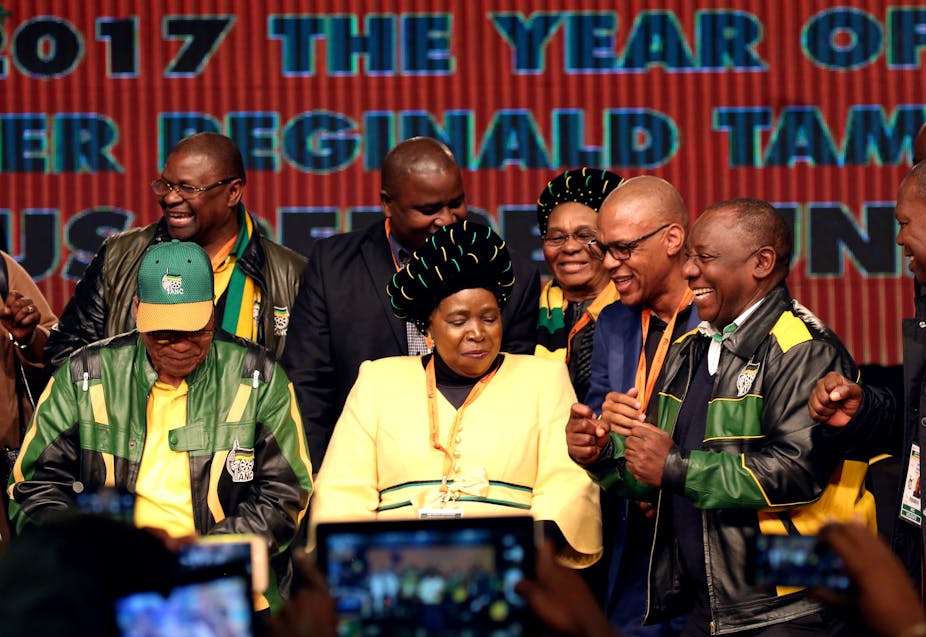The suspense is tangible as the African National Congress (ANC) – South Africa’s former liberation movement that’s turned into a tired governing party – approaches its fiercely contested 2017 elective conference.
By December 5, the party’s branches had largely spoken, and its provincial structures had consolidated the branch delegates’ voting preferences. The lay of the land seemed clear. Yet, on close dissection it’s evident that developments could still subvert what appeared to be definitive trends in branch nominations.
Less than two weeks prior to ballots being cast at the Nasrec Expo Centre in Johannesburg, the contest is closer than both the Polokwane race of 2007, (when Jacob Zuma beat Thabo Mbeki) and 2012 in Mangaung (when Zuma beat then deputy Kgalema Motlanthe).
The branch nominations have confirmed that the two leading 2017 candidates for the ANC presidency are Cyril Ramaphosa and Nkosazana Dlamini-Zuma. While Ramaphosa has a lead, the intricacies of the election process caution against early celebrations: there are black holes that could still devour the advantages he appears to have.
The voting
The voters at the ANC conferences comprise roughly of 90% delegates from ANC branches across the nine provinces. Provinces had been allocated a total of 4,731 delegates (proportionately in terms of membership figures). The rest of the about 5,240 voting delegates come from the ANC’s national executive committee and top six officials (roughly 90 in total). The nine provincial executive committees (27 each, thus 243), the women’s, youth and veterans’ leagues (60 each, thus 180).
The number of branches endorsing Ramaphosa by the evening of December 4 were 1,860 and Dlamini-Zuma 1,333. A total of 3,193 for both candidates, or around 2,000 fewer than the total number of conference voters.
Given that the race will go down to the wire, and that a few hundred ballots in either direction could make a world of difference to the ANC and South Africa, this analysis dissects eight black holes that account for the approximately 2,000 “discrepancy”.
Uncertainties
At the core, the uncertainties that make up the eight black holes are:
The scores released by the ANC’s Provincial General Councils have a “margin of error”. This is because the scores are of branches and not individual delegates. But big branches send more than one delegate and are given more weighting in the voting. This can substantially change the balance between leading candidates come the election.
Mpumalanga province brings its own black box of 223 “unity” votes. The biggest bloc of branches refused to endorse a particular candidate and entered ‘unity’ on nomination forms, following the instruction of provincial leader DD Mabuza. These votes can therefore go to either leading candidate should the delegates cast their vote rather than waste it.
A further uncertainty comes in the exact number of branches that have missed the deadline for their branch general meetings. The deadline for convening these was a week ago. Missing the deadline means they have missed the opportunity to be represented at the conference. The ANC in an interview with the author estimated that between 95-98% made the target date. Exclusions will lower the number of delegates.
A number of branches are caught up in disputes. Challenges centre on the lack of legality of the branch general meetings, some of which have been chaotic. Some battled to reach quorums (50% of members had to be present), or they faked quorums. In other instances officials disappeared with meeting materials and memberships lists, attendance registers were signed off-site, or bickering and fist-fights ruled. These branch delegates could still make it into the voting booths at the conference if the ANC task teams resolve the disputes.
A number of branches and provincial structures have taken their disputes to court. Prominent cases are in KwaZulu-Natal, Free State and the Eastern Cape. The national conference does not ultimately depend on the provincial structures, but provincial leaders may have influenced their branch-based underlings substantially, or have covered up irregularities that affected whom the branches nominated. Disputes at the time of conference could exclude some from voting, or having their votes counted.
The ballots of individual delegates are secret and it’s therefore uncertain to what extent branch nominations will convert into matching votes. Prior conference outcomes show that the branch or provincial counts tended to hold: delegates are inclined to vote according to their mandates. But, political times have changed. Beyond the scrutiny of the superiors and away from branch commissars, delegates might vote according to “conscience”.
Hand-in-hand with individual discretion in the voting act is the practice of “brown envelopes”, or bribes. Speculation is that the bribes could be enormously persuasive, going into six-figure rewards for the right vote.
The final big uncertainty comes via the three leagues - for women, youth and veterans - and the ANC’s executive structures. The large block of around 90 NEC and top-six votes, for example, could split relatively equally between the big candidates. It is this block that has kept Zuma in power through a series of votes in the National Executive Committee, and interventions in parliamentary votes. But, they could by now see that the writing is on the wall given that Zuma will cede his position as head of the party in two weeks time, and his post as head of state in 2019.
Hard to call
The battle lines are drawn and the result is close. Exact calculations will remain impossible; the result is likely to be known by 17 or 18 December. In the interim, all South Africans can do is rely on circumstantial evidence, including signs of confidence or panic in the ranks of the candidates. They can also try and plug the black holes.

